Wisteria Criteria Eat The Weeds and other things, too

Wisteria pictures Beautiful Landscapes, Beautiful Gardens, Beautiful
Wisteria w Donicy na Allegro.pl - Zróżnicowany zbiór ofert, najlepsze ceny i promocje. Wejdź i znajdź to, czego szukasz!

Your Questions about the Getty Gardens, Answered The Getty Iris
Sadzonka Wisterii* Słup bambusowy, krata do donicy lub haczyki do roślin * Powszechną praktyką jest sadzenie glicynii z rozmnażanej żywej rośliny starterowej. Przy uprawie z nasion może trwać od 10 do 15 lat, aby winorośl mogła wyprodukować zakwity w porównaniu z 3 latami, gdy używa się żywego startera.
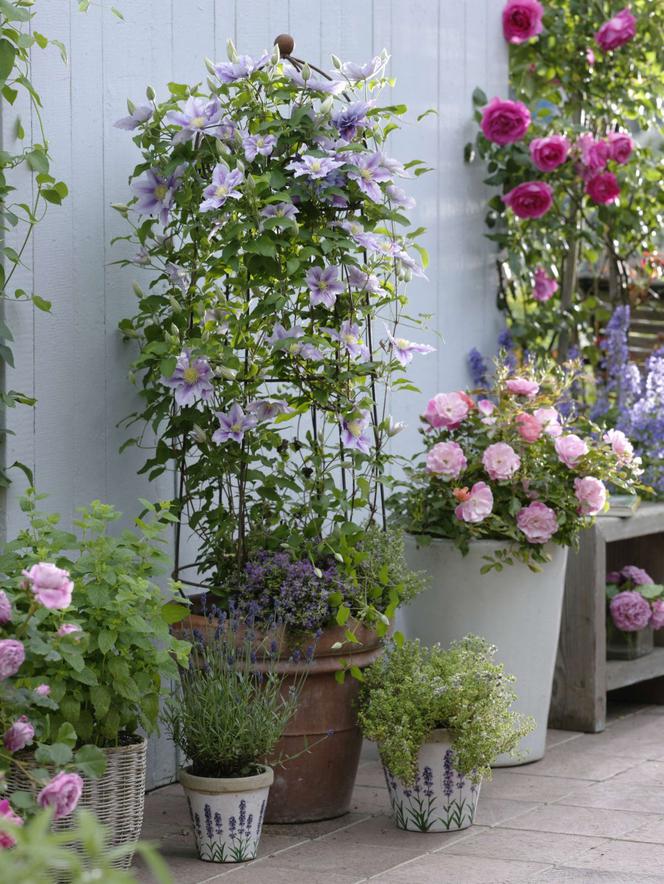
Powojniki na balkon, taras i do ogrodu Urzadzamy.pl
When training wisteria vines, select an upright stem and attach it to the chosen support. Remove any side shoots and continue to train the main vine upwards. New side branches can be trained as needed to fill in spaces of the support structure by attaching them where desired. For best results, keep these side branches spaced about 18 inches (46.

American wisteria (Wisteria frutescens)
There are four common species of wisteria that you'll find in home gardens. These are American (W. frutescens) Kentucky (W. macrostachya), Chinese (W. sinensis), and Japanese (W. floribunda). The different species can all look extremely similar, with pinnate leaves, long panicles of blossoms, and woody stems that can each grow up to 25 feet long.

Wisteria sinensis
The American wisteria ( Wisteria frutescens) is a woody vine with large aromatic clusters of showy purple or white flowers. The drooping conical flowering clusters grow up to 6" (15 cm) long and bloom in April or May after the leaves appear. American wisteria vines thrive in USDA zones 5 through 9.

Chinese wisteria (Wisteria sinensis)
Wisteria w donicy na balkonie i inne pnącza, które warto uprawiać. Porady, wskazówki, inspiracje 2023-08-11 16:56 Pnącza na balkon i taras to świetny pomysł na aranżację przestrzeni i stworzenie tajemniczego, intymnego zakątka. Jednym z najpopularniejszych roślin zwisających na balkon i taras jest wisteria, nazywana też glicynią.
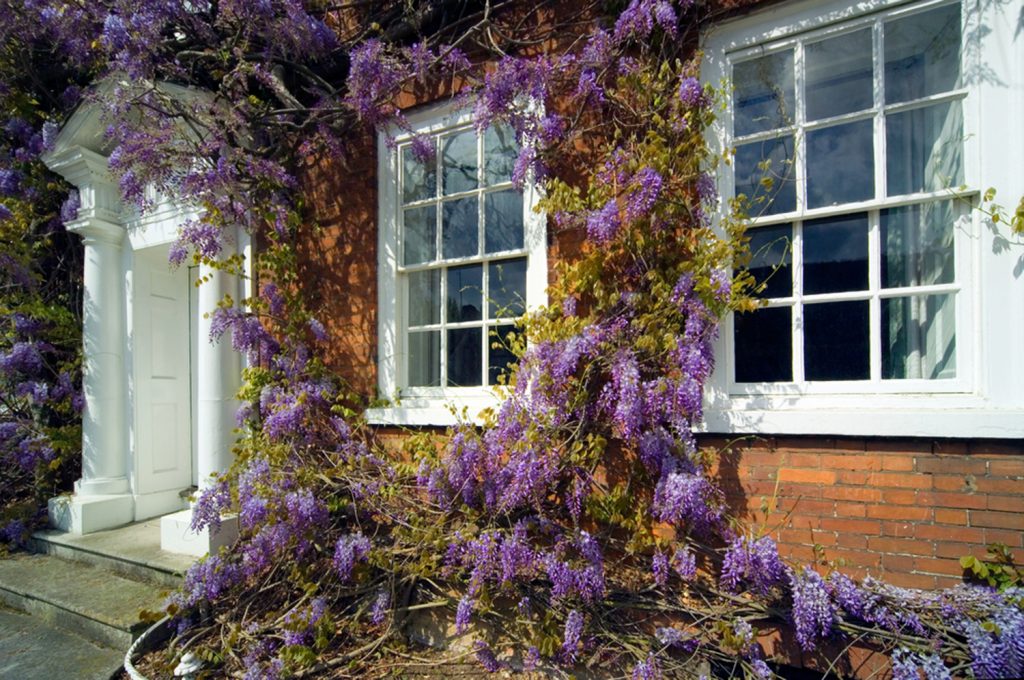
Jak wyhodować Wisterię (glicynię) w doniczce Gardenportal.pl
Stick the bottom of the cutting in a pot filled with moist, sterile mix made of 1/2 peat and 1/2 perlite or 1/2 peat and 1/2 sand. Make sure that at least 1/3 of the stem is buried. Water well and cover the stem and pot with clear plastic. Place in bright, indirect light and keep moist.
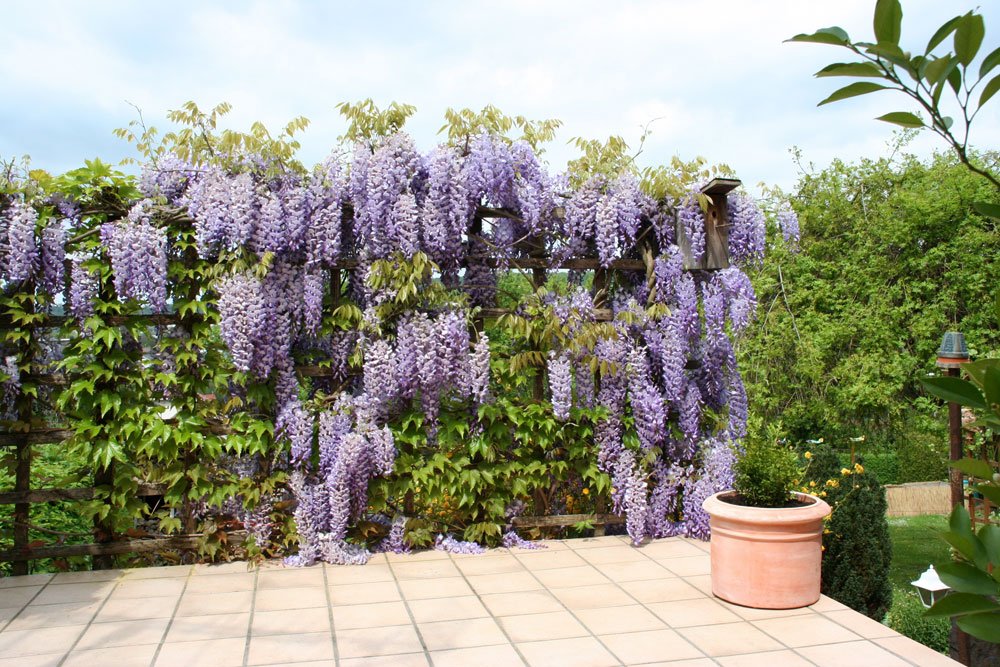
Blauregen Der blauregen (wisteria), auch wisterie, wistarie, glyzinie
Glicynia (Glycine frutescens) nazywana także wisterią (Wisteria speciosa) lub słodlinem jest jedną z najstarszych roślin występujących obecnie w przydomowych ogrodach. Okaz te ma swoje korzenie w Ameryce Północnej, gdzie znany był początkowo pod pierwszą z wymienionych nazw. Dopiero kiedy przywędrował do Europy zaczęto określać go wisterią.
.jpg)
Wisteria Biała Silverita, sztuczna roślina w donicy, wys.155cm tendom.pl
But this requires a maintenance service to prune the vine about every two weeks in summer or your gutters and railings will be ruined. Fortunately, there's a way to safely train wisteria along the top of a ground-floor porch. Run a metal pole from one porch post to another about 18 inches below the crossbeam.
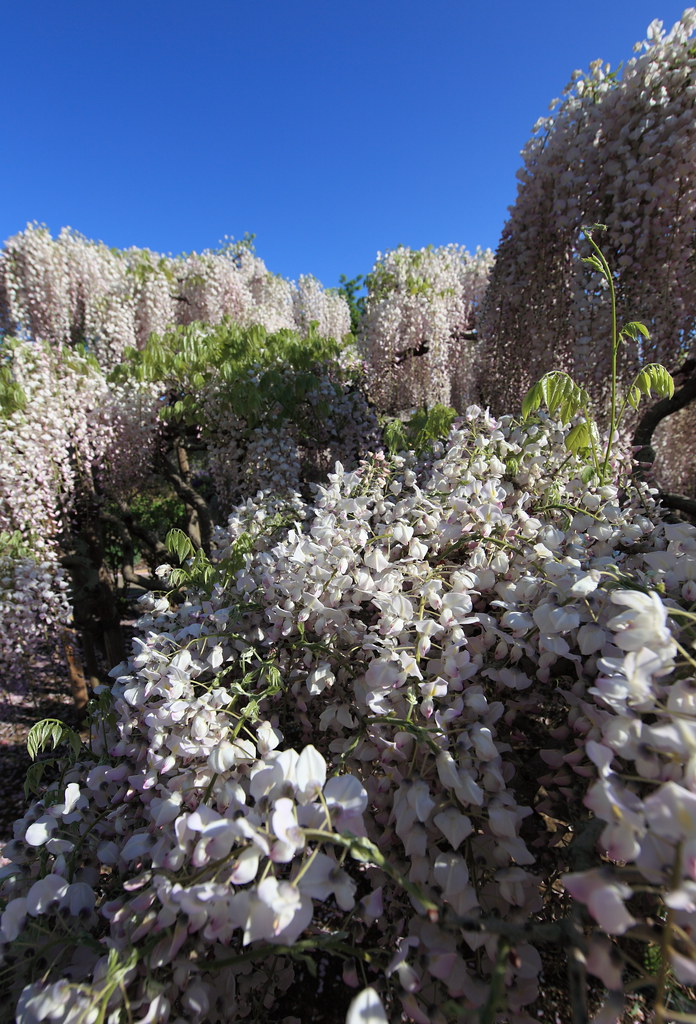
Japanese wisteria / Wisteria floribunda / 藤(フジ) Ashikaga F… Flickr
Glicynia chińska 'Alba' powinna być uprawiana w miejscu słonecznym, ciepłym, osłoniętym od wiatru. Optymalna jest wystawa południowa. Sadzi się ją w glebie żyznej, próchniczej, umiarkowanie wilgotnej o odczynie od lekko kwaśnego do obojętnego. Sadzonki glicynii powinno się umieszczać w gruncie od wiosny do wczesnej jesieni.

Journey with Words Review Wisteria by Bisi Leyton
Wisteria only produces flowers on new canes, so it's best to remove all of the old ones at the end of the growing season in the late fall. Some gardeners in warmer states can start pruning as late as the mid-winter. Remove all of the dead plant matter, leaving only a few buds on each stem. For those gardeners looking to enhance the blooming.

Chinese wisteria (Wisteria sinensis)
Wisteria is a woody, deciduous vine valued for its long (12-18 inches) racemes of fragrant springtime flowers (most often bluish or purplish, but occasionally pink or white). Flowers are succeeded by bean-like pods in fall. Leaf form is pinnate (feather-shaped). There are three main types (two Asian and one American).
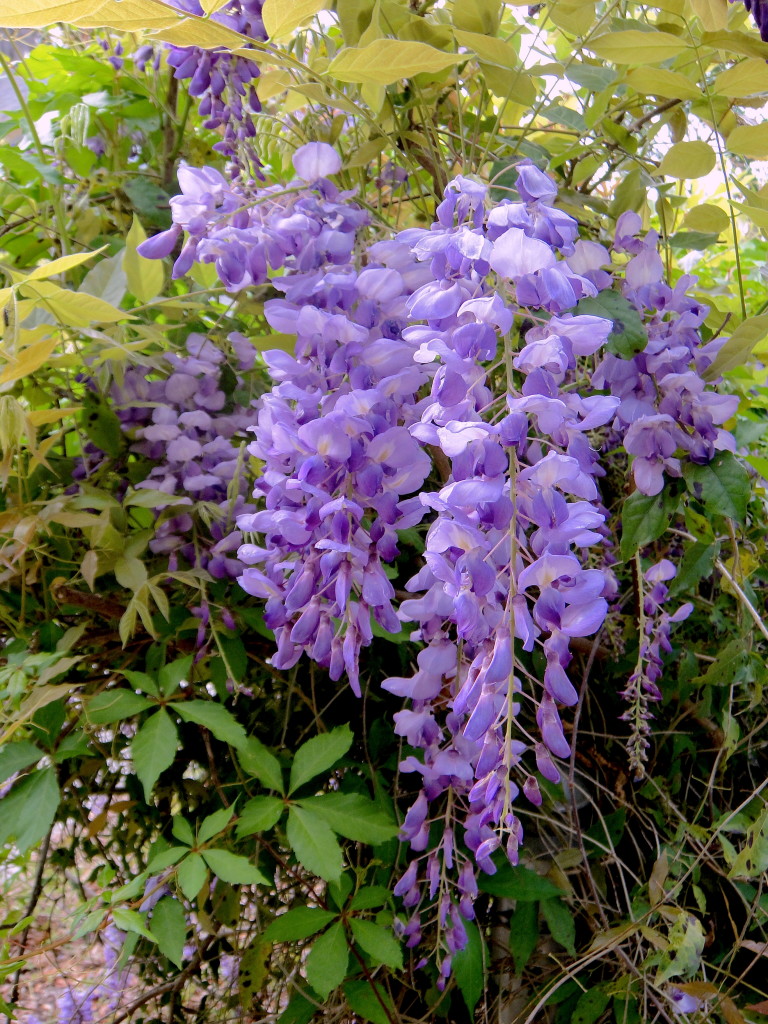
Wisteria Criteria Eat The Weeds and other things, too
This will help to guide water where it's needed most. Wisteria loves to climb, so planting it near a pergola or a fence or wall with added support (wire framing) is great. If you are using wire framing, leave 10cm between the wire and the wall to allow for growth. You can also plant wisteria in a pot, just ensure it is a minimum of 600mm wide.

Boompje Op Stam Met Blauwe Bloemen Bloemen
Caring for Wisteria. Each spring, apply a layer of compost under the plant and a 2-inch layer of mulch to retain moisture and control weeds. Some gardeners swear by phosphorus to aid with flowering. Scratch a couple of cups of bone meal into the soil in the spring and then add some rock phosphate in the fall.
Glicynia Wisteria duża sadzonka w donicy (Glicynia pnącze na altanę
Watering and nutrients. For the first few weeks after planting, give your Chinese wisteria tree a deep watering twice per week. Once it is established, scale your watering schedule back to once per week. After its first year, wisteria trees should grow and thrive on rainfall alone in most climates. Wisteria is a prolific grower, which has led.
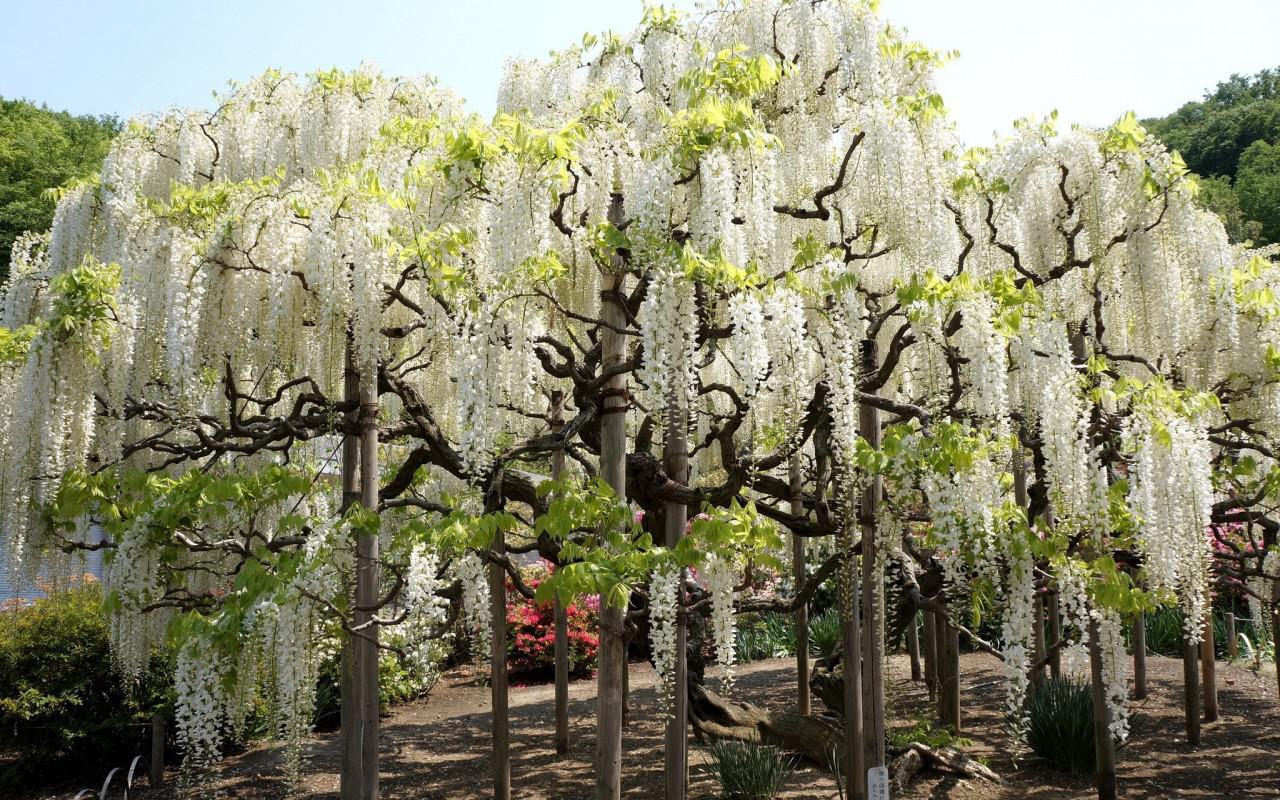
White Wisteria wallpaper 1280x800 32480
Wisteria. Wisteria is a popular ornamental plant that never fails to produce a dramatic floral display. The plant belongs to the pea family (Fabaceae) and is native to Asia, particularly China, Korea, and Japan. Plant: Wisteria is a woody, deciduous vine that can grow up to 30 feet (9 meters) long and spread up to 8-10 feet (2.4-3 meters) wide.